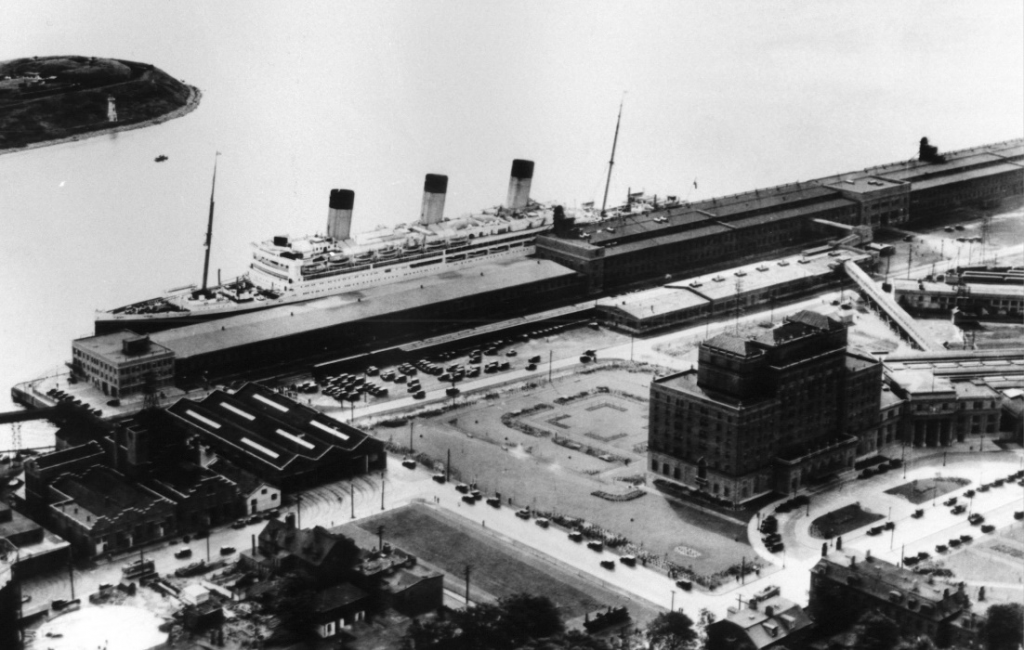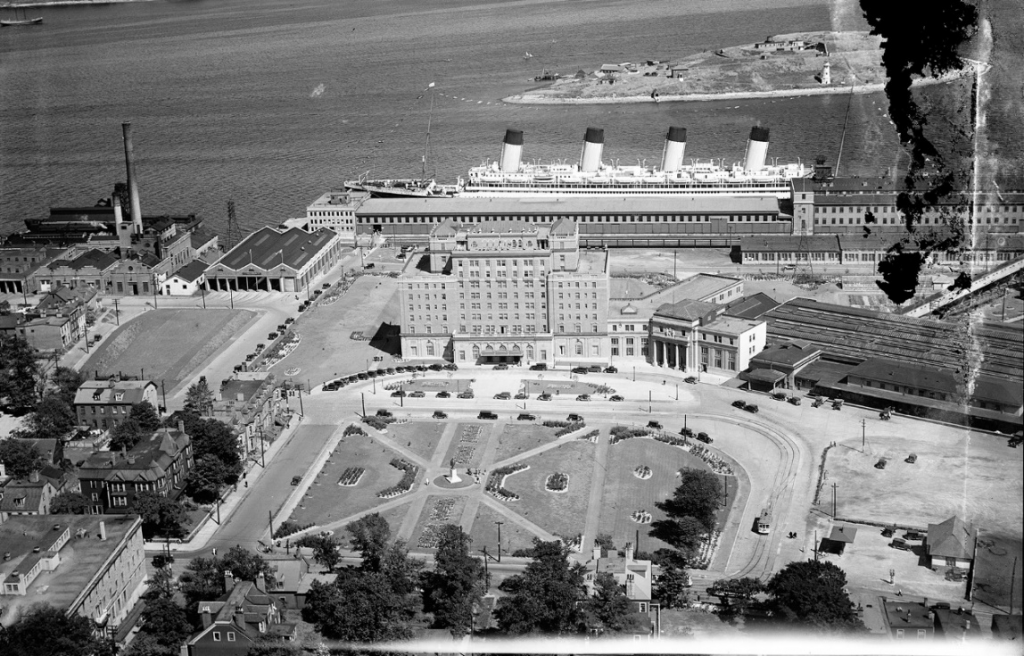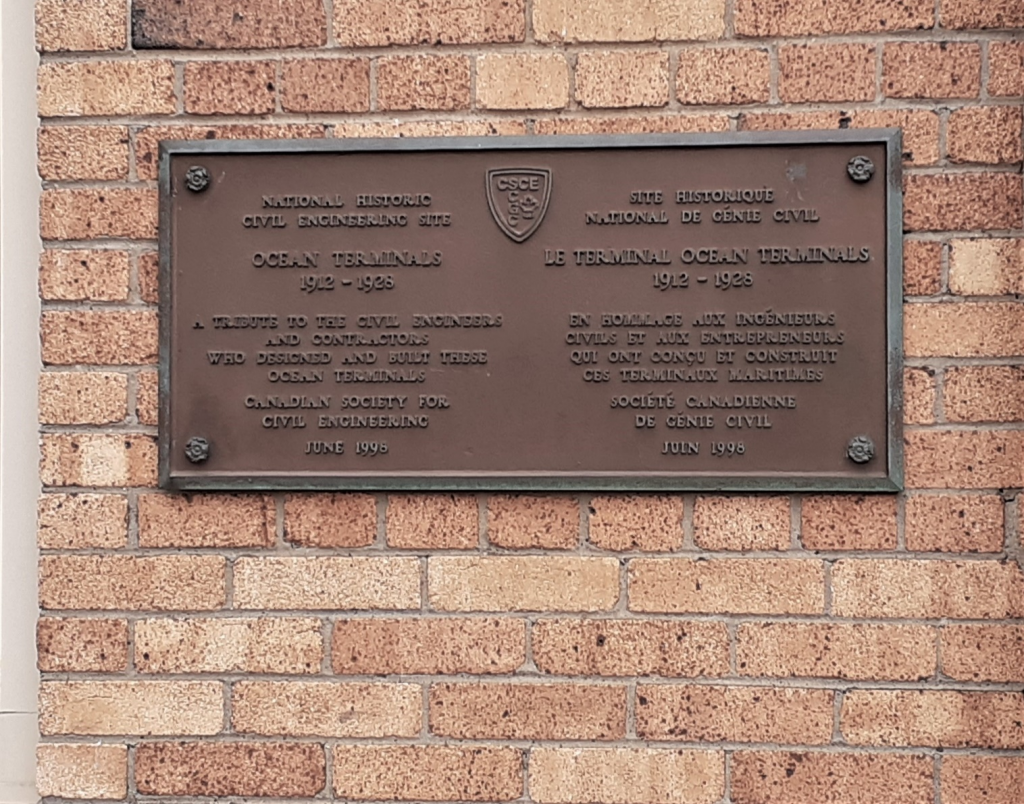
Site Location: The original Ocean Terminals are located on Halifax Harbour between Lat.: 44° – 38’ – 30” N.; Long.: 63° – 33’ – 58” W. (GPS: 44.6417, -63.5661) and Lat.: 44° – 38’ – 05” N.; Long.: 63° – 33’ – 46” W. (GPS: 44.6347, -63.5628). Associated facilities are located on the adjacent land, together with 8 km of railway to Bedford Basin.
Plaque Location: The plaque is located beside the west entrance to the Halifax Port Authority building, 1215 Marginal Road, Lat.: 44° – 38’ – 29” N.; Long.: 63° – 33’ – 59” W. (GPS: 44.6414, -63.5664). Travelling south on NS-102 S in Halifax, turn right (south east) from Bayers Road on Connaught Ave and, after 1.8 km, turn left (east) onto Jubilee Road. Proceed 0.3 km and turn right (south) on Oxford Street, and proceed 0.8 km to turn left (east) on South Street. Proceed 2.2 km to the end of South Street and turn left (north) on Hollis Street, which soon turns right (east) and becomes Terminal Road. Proceed for 0.2 km, bending right onto Marginal Road. The Port Authority building is on the waterfront to the left of Marginal Road. Transit: Take bus #29 to the Hollis Street/Terminal Road intersection, and walk 200 m east on Terminal Road and Marginal Road. Or walk to the plaque at the south end of the Halifax Waterfront Boardwalk.

Description: In 1905, the Government of Canada took control of the dockyards in Halifax after the withdrawal of the Royal Navy.
The Ocean Terminals project was a landmark renewal of the port infrastructure in Halifax. The main focus was construction of deep water piers at the south end of the city to accommodate passenger and commercial vessels. Begun in 1912, construction continued through World War I and the Halifax Explosion. When completed in 1928, the wide-ranging development included: 8 km (5 mi.) of railway; a 500 m (1640 ft.) breakwater; and, Piers 20 to 28 with over 1700 m (5600 ft.) of berthing face. Other port-related facilities included passenger and transit buildings, grain elevators, a railway station and a hotel.
There were many notable aspects of construction. The pier construction typically employed stacked precast concrete blocks to provide a draft of 13.7 m (45 ft.). The rock cut for the railway, up to 20 m (65 ft.) deep, provided extensive landfill for both the Ocean Terminals area to the south and along Bedford Basin to the north. Sixteen new concrete bridges maintained access across the new railway.
The railway contractors were Cook Construction Co. Ltd., Sudbury, ON, and Wheaton Bros., Amherst, NS. The pier contractors were Foley Bros., Welsh, Stewart & Fauquier. James Macgregor was responsible for the design and construction as the Superintending Engineer for the Canadian government.

Historic Significance: From 1928 to 1971, approximately one million immigrants came to Canada through Pier 21, the last surviving seaport immigration facility in Canada. The terminal also carried extensive traffic during World War II, moving 400,000 military personnel overseas. Accordingly, Pier 21 is recognized as a National Historic Site and is home to the Canadian Museum of Immigration.
The bustling area from Berths 20 to 23 is now referred to as Halifax Seaport, and serves as the main cruise ship terminal in Atlantic Canada. Along with the museum, the area also houses the Seaport Farmers Market, the Nova Scotia College of Art and Design and the Cunard Centre, a multi-purpose facility. Meanwhile, the adjacent Westin Nova Scotia Hotel and Via Rail Train Station continue to strengthen the transportation hub.
Nearly a century later, deep water Berths 24-28 still serve a diversity of cargoes. The railway spur and infrastructure maintain a vital link to the Ocean Terminals, as well as the nearby container terminal.


Plaque Wording: CSCE. National Historic Civil Engineering Site. OCEAN TERMINALS 1912-1928. A tribute to the civil engineers and contractors who designed and built these ocean terminals. Canadian Society for Civil Engineering. June 1998.
SCGC. Site Historique National de Génie Civil. LE TERMNAL OCEAN TERMINALS. 1912-1928. En hommage aux ingénieurs civils et aux entrepreneurs qui ont conçu et construit ces terminaux maritimes. Société canadienne de génie civil. Juin 1998.
Links to Online Documentation:
“Halifax Ocean Terminals”, Halifaxbloggers.ca
Canada’s Historic Places, “Pier 21 National Historic Site of Canada”.
Canada Science and Technology Museum “Picturing the Past”. (In the ‘Advanced Picture Search’, search the STR Collection with the keyword “Halifax”).
Steven Schwinghamer, “Historic Pier 21”, CIHS Bulletin, 2018.
Halifax Urban Greenway, “Development of the Halifax Railway Cut (1912-18)”.